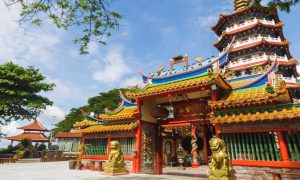Exploring the Hilly Slopes of Penang’s Famous Hill

[img_gallery][/img_gallery]
Austen and Frances Wilks explores the unfrequented tracks and by-ways on the side slopes of Penang Hill, but let the train to take the strain to enjoy the comforts of the summit.
The air is often cool and crisp at the top of Penang Hill, accessible via the refurbished funicular railway, which can now deliver you from the Base to the Summit Station in as little as five minutes to about 740 metres above sea level. If you are like us you may hurry past the popular attractions grouped around the station. If you lingered you could have your photo taken with an exotic animal, or take home a souvenir showing your head superimposed on an artificial plant, or choose a design to be painted on your arm or leg. A few steps further on is the Summit Road which leads away to stupendous views of the forest canopy, distant Georgetown, Penang Roads and the Mainland below. You could take a tour along this road by electric golf buggy.
See Also: Penang’s Hill Station
Sound of horns and motors
Unfortunately for the walkers, the welcome silence of these vehicles has a downside: the drivers are trained to sound their horns to warn people on the road of their approach. This can tend to impair the experience of the ten-million-year-old rainforest just out of reach on the uncleared sides of the hill.
If you want an alternative and are supremely fit and strong, you could avoid the railway altogether and take one of several foot paths from the plain to the summit, but it’s a tough climb. However, not everyone has the energy or time for this. Taking the train to one of the higher intermediate stations gives you instant access to the blessed coolness of high altitude. Enjoy the solitude of being a little off the beaten track by walking along one of the level ‘Roads’ that run across the East-West slopes of the hill. We chose Moniot Road Halt for the start of our adventure because it is said to be part of the Sedan chair route developed for early European visitors – from the late eighteenth century onwards.
Sounds of ancient forests
At over 600 meteres altitude, the air seems just as cool and delicious as at the summit and there is an intense silence. You can just catch the soughing of the breeze through the ancient trees, the chatter of a dead leaf as it shakes in a corridor of wind and the faint jungle noises of cicadas. In the distance there’s birdsong, maybe the whooping of a monkey troupe, and as you move along the smooth flat roadway in the dry season, perhaps you will hear the crackle of a small animal unseen in the undergrowth, as it scampers through the dry leaves underfoot when alarmed by your presence.
We enjoyed the feeling of being so close the primeval forest, sections of which are almost completely undisturbed.
Roads and gradients From Moniot Road Halt the Moniot ‘Road’ is a narrow forest path with intermittent sections of concrete. It is now hardly wide enough to be the route for a sedan chair. With the passenger in the middle in the chair between the poles, and two men at front and rear, each holding a pole, you would need a pathway to accommodate three abreast. If Moniot Road is part of the route followed using this method, then it would have zig-zagged upwards on a moderately steep path, with the expected hairpin bends at the end of each zig and zag.
The Halt is on the East side of the rail track which bisects the Moniot Road at this point. You cannot cross here. Going eastwards within a few hundred metres you will meet one of the hairpin bends that lead up to the next level ‘Road’ – Viaduct Road East. As you approach the railway again, you find that it had to be raised to accommodate a dip in the gradient of the hill. You can pass under the arches of the viaduct onto Viaduct Road West, and sample the continuing peace and quiet disturbed only by the very occasional motorbike or 4×4.
On the map we saw that there was a steep path leaving the level way, a short cut leading to the Jeep Road which runs from just outside the Botanic Gardens to the top. We did not take it, but continued on Viaduct Road West. After less than a kilometre this road too joins the Jeep Road after another hairpin bend.
The Jeep Road is really steep, designed for motor transport, wide and well-maintained. Although the surface is good, the gradient was not suited to our mature European legs! After toiling past Grace Dieu bungalow (looking distinctly European surmounted with its weather cock) we decided to loop back down the short cut. Here we learned a new lesson about the nature of the hill as we found ourselves clambering down a dry watercourse. The incessant rains of the wet season had naturally taken this channel, and had begun to cut deep grooves into the hillside. We were glad to complete the scramble back to Viaduct Road West, which is almost level from this point back to Viaduct Station.
You could carry a picnic and eat it by the side of the road, but we intended to catch the train to the top for a civilised lunch. (See ‘Managing the train’)
Butterfly capture
After lunch we took the Summit Road – Jalan Sultan Yahya Petra – and experienced its busy wheeled traffic before descending on one of the many steep paths that that lead to the next level road down – Tunnel Road West. Travelling eastward it’s a lot further to return to the railway line than on the Summit level, because of the swell of the hill.
On the way I saw a butterfly stooping repeatedly over the pollen-filled flowers that pattern the roadside, and after several attempts with my camera managed to get a focused shot. A little later we took the down train from Upper Tunnel Station, where I saw another butterfly – this one painted on the hand of an elegant lady tourist. Which would you prefer, this very well-executed piece of body art – or the real thing?
Managing the Train
Since the most recent renovation, the train now races to the top in five minutes without stopping. If you want to alight at an intermediate station, ask the driver at the time of boarding in the base station. His control position is at the front of the train when going up.
To stop the train at an intermediate station you need to use the monkey-proof ‘Intercom’ (telephone box) installed at every halt. Slightly over-illustrated instructions for use of the box are provided with legends in English only. Do not be put off by the heading:
‘For Resident/Staff/Emergency Use Only’
Not wanting to misuse the Intercom, the first time we needed to stop the train we rang the alternative mobile phone number listed under panel number 8 – which is 04-8288813. The telephone was answered by the Security Controller who did alert the driver of the next train in the desired direction, but he courteously asked us to use the Intercom in future to speak directly to the Traffic Controller.
Our first attempt to stop the train must have looked pretty funny. Before the renovation – when the journey took half-an-hour – all you had to do was put out your hand to stop the train. We tried this (I even waved my floppy hat), but the train flashed past and goggle-eyed tourists gaped at us. On a down train, the driver would not even see you, as he is located at the back of the descending vehicle.
Do observe the safety instructions. Keep behind the safety gate which can be opened by the driver for you when the train comes to a halt. Do not, under any pretext, attempt to cross the track on foot!
Essential Preparations
Wear sensible shoes. Take as much water as you can comfortably carry. Protect your skin from sun and insects. Wear a hat. Don’t forget your mobile phone, and ensure it is charged.
Source: Penang International April/May 2014
Read more:
- The Merlin of Penang: Sjovald
- Photo Essay: The Penang of the Past
- Where to Find the Best Mamak Mee and Oyster Omelette in Penang?
What are your thoughts on this article? Let us know by commenting below.No registration needed.

















